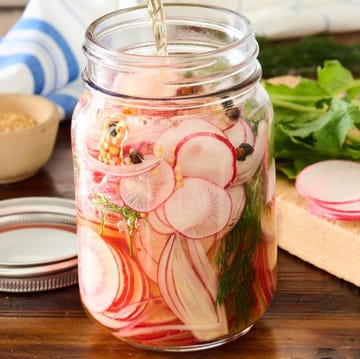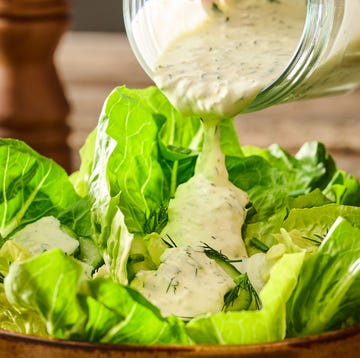
Yields:
6 c.
Prep Time:
15 mins
Total Time:
1 hr 15 mins
If your summer harvest yields a surplus of tomatoes, make yourself (or maybe some lucky friends and neighbors) a batch of fresh tomato sauce. While there is no shortage of delicious ways to enjoy tomatoes, this sauce is a great way to use a mountain of the juicy red fruit quickly before they over-ripen. With a clean, slightly sweet flavor, fresh tomato sauce is the perfect start to classic Italian dishes like spaghetti and meatballs and eggplant parmesan. I bet you'll find dozens of ways to use this super versatile tomato sauce, so feel free to get creative!
What kind of tomatoes are best for fresh tomato sauce?
While cherry and grape tomatoes are not the best candidates for this type of sauce, any other type of fresh tomato will work wonderfully—from plum to beefsteak to vine-ripened to heirloom! Just be sure to pick out red tomatoes or the color of the sauce might be a little funky yet tasty.
Heartier varieties, like Roma and plum, have thicker skins and a lower moisture content. For that reason, they'll yield a more concentrated sauce. If you use a variety of tomatoes and your sauce isn't quite as thick or rich-tasting as you'd like, continue to simmer the sauce with the lid off until it's reduced to your liking.
How ripe should tomatoes be for sauce?
Use ripe tomatoes for this fresh tomato sauce. Underripe tomatoes tend to be tart and can give the sauce a b flavor. That said, the ripe tomatoes don't have to be beauties! If you have some garden tomatoes that have cracks or bruises, this is the perfect way to use them. If you're not a tomato grower yourself, you may be able to score a discount on some imperfect tomatoes at the farmers' market!
How do you tell if a tomato is ripe?
Ripe tomatoes feel heavy and have a slight give to them when squeezed. Some varieties turn darker red when they're ripe, but color isn't always the best indication, so squeeze each tomato gently before adding it to your sauce.
Does homemade tomato sauce freeze well?
Homemade tomato sauce freezes beautifully. If you have a garden full of fresh tomatoes, feel free to make a double or even triple batch and freeze it to enjoy for months. Once the sauce is cool, transfer it to airtight containers or zip-top bags and store it in the freezer for up to six months.
I like to freeze the sauce in smaller one- or two-cup portions, so I can defrost just the amount I need at a time.
Do you have to peel fresh tomatoes for sauce?
Many recipes require blanching and peeling the tomatoes or passing them through a food mill to remove the skin. Some people even remove the seeds for a more uniform texture. To save time and still get great results, for this recipe, you only need to remove the bitter core and keep the skin and flavorful, juicy seeds. Blitzing the tomatoes in a blender breaks down the skin for a smooth sauce.
How do you properly can fresh tomato sauce?
If the goal is to preserve every tomato in the harvest, you can easily double this recipe. Canning your tomato sauce means you can enjoy a fresh taste of sunshiny summer in the middle of chilly December! You'll thank yourself later. Boiling the canned tomatoes kills bacteria, removes oxygen, and vacuum seals the jar lid for that satisfying pop. It also makes an incredibly special homemade food gift!
Advertisement - Continue Reading Below
Ingredients
- 5 lb.
plum tomatoes, cored and quartered
- 2 Tbsp.
unsalted butter
- 4
cloves garlic, minced
- 2 tsp.
kosher salt, plus more to taste
- 1/2 tsp.
black pepper
- 2 Tbsp.
olive oil
- 2
sprigs fresh basil
Directions
- Step 1In a blender, blend the tomatoes, in batches as necessary, until an almost smooth pulp forms. Pour into a large bowl; there should be about 10 cups of puree.
- Step 2In a large Dutch oven, melt the butter over medium-high heat. Add the garlic and cook until fragrant, about 30 seconds.
- Step 3Stir in the tomato puree, salt, and pepper. Bring to a boil, stirring frequently. Reduce the heat to medium-low, and simmer until the sauce reduces by one-third, 45 minutes to 1 hour.
- Step 4Remove the pot from the heat and stir in the oil and basil. Add salt to taste.
Tip: Cover and refrigerate the tomato sauce for up to five days. The sauce can be placed in zip-top bags or airtight containers and frozen for up to six months.
Advertisement - Continue Reading Below

Relish in the Zesty Flavor of These Pickle Recipes

Does Honey Expire?

Easy Homemade Blackberry Jam

Quick and Easy Pickled Radishes
Advertisement - Continue Reading Below
Advertisement - Continue Reading Below







